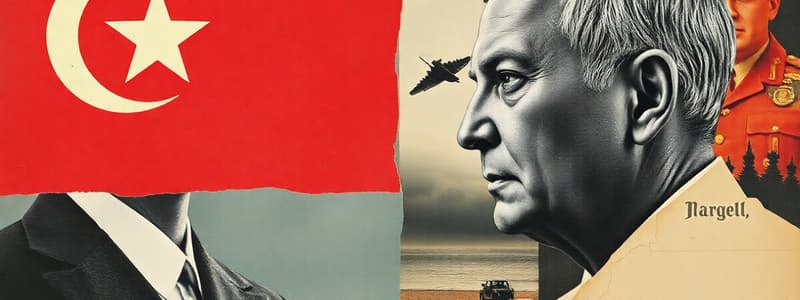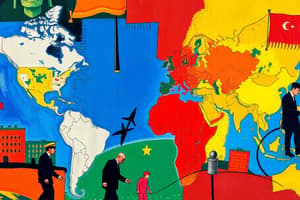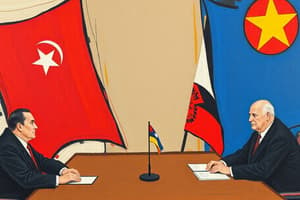Podcast
Questions and Answers
What was the primary underlying cause of the Cold War?
What was the primary underlying cause of the Cold War?
- The unresolved territorial disputes from World War I.
- The rise of fascism in post-war Europe.
- The power vacuum created after World War II and the conflicting ideologies of the United States and the USSR. (correct)
- The economic devastation of Europe, leading to increased competition for resources.
How did the involvement of colonies in World War II affect their relationship with imperial powers?
How did the involvement of colonies in World War II affect their relationship with imperial powers?
- Colonies were inspired to challenge imperial rule due to their contributions and the weakening of imperial powers. (correct)
- Colonies became more economically dependent on imperial powers due to wartime debts.
- Colonies were granted greater autonomy during the war in exchange for resources and manpower.
- Colonies had an increased sense of loyalty to imperial powers due to shared sacrifices during the war.
Which of the following best describes the key difference between the decolonization of India and Vietnam?
Which of the following best describes the key difference between the decolonization of India and Vietnam?
- India's independence was achieved through violent revolution, while Vietnam's independence was negotiated peacefully.
- India's independence was primarily economic, while Vietnam's independence was based on cultural factors.
- India's independence was achieved through negotiation, while Vietnam's independence was gained through violent conflict. (correct)
- There was no difference. Both countries gained independence through similar methods.
What was the main purpose of the Berlin Wall during the Cold War?
What was the main purpose of the Berlin Wall during the Cold War?
What was the significance of the Bandung Conference of 1955?
What was the significance of the Bandung Conference of 1955?
How did the Yalta and Potsdam conferences shape the post-World War II world?
How did the Yalta and Potsdam conferences shape the post-World War II world?
What was a primary long-term effect of the Cold War?
What was a primary long-term effect of the Cold War?
Why were the Korean and Vietnam Wars considered proxy wars during the Cold War?
Why were the Korean and Vietnam Wars considered proxy wars during the Cold War?
Which movement is Mahatma Gandhi most known for?
Which movement is Mahatma Gandhi most known for?
What was the Marshall Plan?
What was the Marshall Plan?
What was one significant result of the Chinese Communist Revolution of 1949?
What was one significant result of the Chinese Communist Revolution of 1949?
What was the Cuban Missile Crisis?
What was the Cuban Missile Crisis?
What was the 'Year of Africa'?
What was the 'Year of Africa'?
What role did espionage play during the Cold War?
What role did espionage play during the Cold War?
What was Mutually Assured Destruction (MAD) and how did it affect the Cold War?
What was Mutually Assured Destruction (MAD) and how did it affect the Cold War?
Which of the following best explains the ideological tensions of the Cold War?
Which of the following best explains the ideological tensions of the Cold War?
How did WWII contribute to the rise of decolonization movements?
How did WWII contribute to the rise of decolonization movements?
What was the primary goal of the Viet Cong during the Vietnam War?
What was the primary goal of the Viet Cong during the Vietnam War?
How did the Pinochet regime in Chile (1974-1990) exemplify Cold War tensions in the Western Hemisphere?
How did the Pinochet regime in Chile (1974-1990) exemplify Cold War tensions in the Western Hemisphere?
Which event is considered a symbolic end to the Cold War?
Which event is considered a symbolic end to the Cold War?
Flashcards
The Cold War
The Cold War
A period of geopolitical tension between the United States and the Soviet Union, characterized by proxy wars, espionage, and ideological clashes.
Decolonization
Decolonization
The dismantling of colonial empires following World War II, resulting in newly independent nations.
Causes of WWI
Causes of WWI
Nationalism, imperialism, and alliances.
Axis Powers (WWII)
Axis Powers (WWII)
Signup and view all the flashcards
Allied Powers (WWII)
Allied Powers (WWII)
Signup and view all the flashcards
Capitalism
Capitalism
Signup and view all the flashcards
Communism
Communism
Signup and view all the flashcards
Cause of the Cold War
Cause of the Cold War
Signup and view all the flashcards
NATO
NATO
Signup and view all the flashcards
Warsaw Pact
Warsaw Pact
Signup and view all the flashcards
The Berlin Wall
The Berlin Wall
Signup and view all the flashcards
Proxy Wars
Proxy Wars
Signup and view all the flashcards
The Space Race
The Space Race
Signup and view all the flashcards
Negotiated Independence
Negotiated Independence
Signup and view all the flashcards
Violent Independence
Violent Independence
Signup and view all the flashcards
India's Independence
India's Independence
Signup and view all the flashcards
Vietnams Independence
Vietnams Independence
Signup and view all the flashcards
Bandung Conference
Bandung Conference
Signup and view all the flashcards
Creation of Israel
Creation of Israel
Signup and view all the flashcards
Year of Africa (1960)
Year of Africa (1960)
Signup and view all the flashcards
Study Notes
- Unit 8 encompasses the Cold War and decolonization as significant post-World War II effects that reshaped global politics and had lasting impacts.
- The unit emphasizes how World War II ushered in a new era marked by emerging powers and trends that shaped the modern world.
- The Cold War was a power struggle after WWII, while decolonization stemmed from post-war independence movements in Africa and Asia.
Contextualizing Unit 8
- World War I was caused by nationalism, military growth from the Industrial Revolution, imperialism, and alliances.
- The failure of the Treaty of Versailles after WWI led to the issues that would contribute to WWII.
- Economic struggles in Germany led to the rise of Adolf Hitler and the Nazi Party, who blamed Jews and Slavs for Germany’s problems.
- Germany's invasion of Poland in 1939 started World War II.
- The Axis Powers in WWII consisted of Germany, Italy, and Japan.
- The Allied Powers included the United States, France, Britain, and the USSR.
- At the end of World War II, the United States and the USSR emerged as the main Allied victors.
- The United States was a capitalist nation, whereas the USSR was a communist nation.
- The power vacuum after WWII led to the Cold War.
- The Cold War involved espionage, proxy wars, and hostility.
- Colonies began to seek independence due to their involvement in the war.
Big Ideas in Unit 8
The Cold War
- The Cold War was a conflict between the USA and USSR over capitalism and communism.
- Countries aligned themselves into NATO and the Warsaw Pact.
- Germany was divided into East and West Germany, and the Berlin Wall became a symbol of Cold War tensions.
- The USA and USSR engaged in proxy wars like the Korean and Vietnam Wars.
- Espionage and threats were indirect forms of hostility during the Cold War.
- Mutually assured destruction prevented nuclear warfare between the USA and USSR.
- The space race became an ideological and nationalist competition between the USSR and USA.
Decolonization
- World War II led to decolonization, where colonies fought for independence.
- Negotiated independence involved legal means, such as in India with Mahatma Gandhi's boycotts and marches.
- Violent independence involved war, such as in Vietnam and Algeria.
- New states like Bangladesh, Pakistan, and Israel were formed, which led to conflict.
Main Events
- 1914-1918: World War I
- 1918-1920: Estonian war for independence
- 1919: Gandhi’s first satyagraha; Egyptian Revolution; Syrian National Congress convenes
- 1919: May 4th Movement
- 1929: Great Depression begins
- 1929-1947: Indian protest for independence
- 1931-32: Japanese invasion of Manchuria
- 1933: Great Depression ends
- 1939: World War II starts
- 1945: World War II ends/Yalta and Potsdam conferences
- 1947: Marshall Plan
- 1948: Israel created
- 1949: NATO formed//China established as a communist country
- 1950-53: Korean War
- 1955: Bandung Conference
- 1957: Ghanaian independence
- 1959-1975: Vietnam War
- 1960: Year of Africa (independence of 17 African nations, such as Nigeria and Cameroon)
- 1962: Cuban Missile Crisis
- 1963: Kenyan independence
- 1974-1990: Pinochet in Chile
- 1975-2002: Angolan Civil War
- 1989: Year of independence of many countries from the Soviet bloc/collapse of the Berlin Wall
Studying That Suits You
Use AI to generate personalized quizzes and flashcards to suit your learning preferences.




